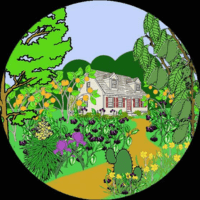Garlic Chives - How to Grow Organic Herbs
Garlic Chives are similar to a Chives EXCEPT, Garlic Chives have a ‘sha bang,’ garlicy taste. The name, Garlic Chive fits this plant perfectly!
It’s been cultivated by the Chinese for 3,000 years. Garlic Chives, Allium tuberosum looks similar to a Chives, Allium schoenoprasum but there’s some clear differences. For starters, Garlic Chives are MUCH easier to grow than Chives. It’s is a super easy herb to grow, to cook, and easy to propagate (sometimes too easy!).
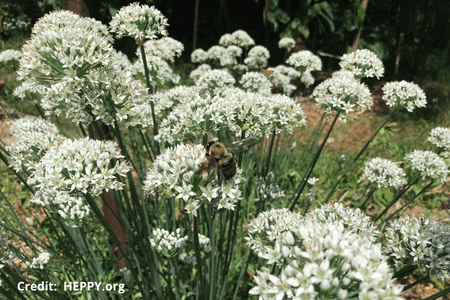
On THIS webpage!
Learn How To Grow, What’s on this webpage?
- Garlic Chives vs Chives
- Genus Allium – EVERYTHING chivey, oniony, garlicy, leeky
- Garlic Chives Fact Sheet
- Garlic Chives in the Kitchen
- Medicinal and Medical Benefits
- Grow, Care & Propagate Garlic Chives
- Garlic Chives herb growing at HEPPY™!
________________________________________
see our list of 400 edible plants
YouTube channel
YouTube playlist for Herbs
Garlic Chives vs Chives
Garlic Chives and Chives look very similar. however, their flavor, flowers, vigor differ greatly. Garlic Chives, Allium tuberosum and Chives, Allium schoenoprasum are wonderful herbs to eat, and have many uses.
Similarities - Garlic Chives vs Chives
- perennial plants that grow from small bulbs (bulbs much smaller than a green onion).
- grows in dense clumps.
- tubular, grass-like, dark green “leaves” about 12″ tall.
- virtually pest and disease free.
- used a flavor and color in culinary dishes.
- insecticidal (repellent) qualities.
Differences - Garlic Chives vs Chives
- flowers. Garlic Chives have white flowers and Chives have purple flowers.
- hardiness. Garlic Chives are hardier. they can withstand lower amounts of water than Chives.
- taste & smell. Garlic Chives have a stronger flavor profile, with Garlic taste and smell overtone. Garlic Chives’ crushed ‘leaves’ give a distinct chivey garlicy smell.
- ‘leaves’. both have tubular, grass-like, dark green “leaves” about 12″ tall. however, Garlic Chives’ leaves are about twice the diameter and a bit flatter. Chives have thinner leaves and they’re round.
- aggressiveness. Garlic Chives aggressively self-seed. we top (deadhead) blooms immediately. Garlic Chives have a more well-rooted bulb. they don’t pull out of soft soil without the use of a hand shovel. it’s dense clump expands quicker; however, that is easily manageable. deadhead the Garlic Chive. if not, you’ll have the plant spread wider and wider each year.
I enjoy Garlic Chives more than Chives. They are hardier so NO maintenance is required. I cook with far less of it to get the same Chive flavor. just…deadhead this girl….
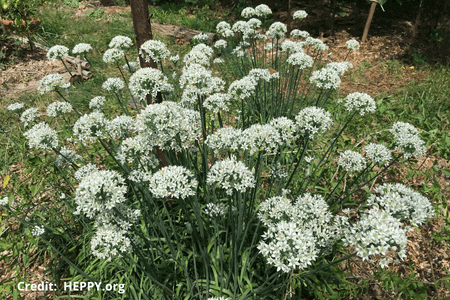
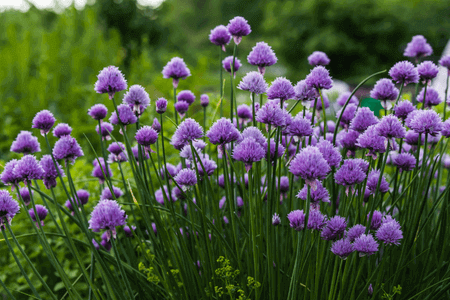
Genus Allium
Allium is a genus (parent) with hundreds of species (children). Allium means Garlic in Latin.
Allium species have been studied for possible cancer treatment (garlic, onions, leeks, chives, and shallots). another study cites, “Allium species constituents have been shown to have antibacterial and antioxidant activities…[and] other biological properties. These activities are related to their rich organosulfur compounds. These organosulfur compounds are believed to prevent the development of cancer, cardiovascular, neurological, diabetes, liver diseases as well as allergy and arthritis.” they don’t just taste great, they’re good for you!
Allium species
Chives, Garlic, Leek and Onion have many well known cultivated species. however, there are interesting uncultivated Allium species. we pick Allium vineale (called Wild garlic or Wild Onion) out of our lawn!
- Garlic Chives, Allium tuberosum
- Chives, Allium schoenoprasum
- Garlic, Allium sativum
- Elephant Garlic, Allium ampeloprasum var. ampeloprasum. It’s “Garlic” by name but a species of Leek.
- Field Garlic, Allium oleraceum
- Wild Garlic, Allium vineale (also referred to as a Wild Onion)
- Onion, Allium cepa
- Shallot is in the Onion family, such as the French Red Shallot, Allium cepa var. aggregatum
- Chinese Onion, Allium chinense
- Green Onion or Scallion (Bunching Onion), Allium fistulosum
- Wild Onion (uncultivated)
- Aspen Onion or Twincrest Onion, Allium bisceptrum
- Canada Onion or Canadian Garlic, Allium canadense
- Swamp Onion or Pacific Onion, Allium validum
- Leek, Allium ampeloprasum
- Wild Leek, Allium ampeloprasum (uncultivated)
- Ramp, Allium tricoccum (also referred to as a Wild Onion)
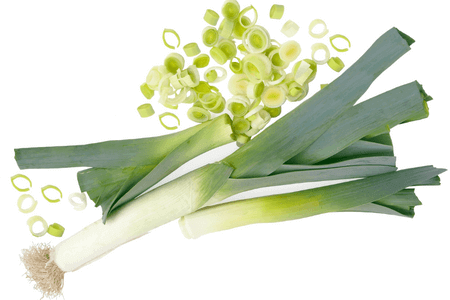
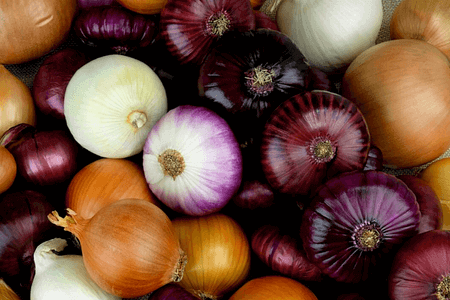
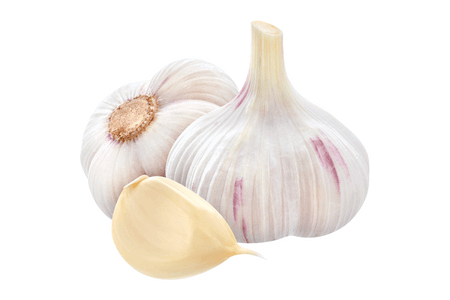
Garlic Chives and Chives Fact Sheet
Garlic Chives, Allium tuberosum
Chinese Chives and Oriental Chives are also common names for Allium tuberosum.
it’s native to China.
Zone: 3 to 9
Height: 1 1/2 feet (0.5m)
Self-fertile: yes
Sun: full sun to part shade
Water: low
Soil: forgiving
Bloom: white flowers appear in August – September
Family / Genus: Amaryllidaceae / Allium
Chives, Allium schoenoprasum
Wild Chives and Flowering Onion are also common names for Allium schoenoprasum.
it grows across Europe, Asia and North America.
Zone: 4 to 8
Height: 1 1/2 feet (0.5m)
Self-fertile: yes
Sun: full sun to part shade
Water: medium
Soil: forgiving but not as forgiving as Garlic Chives
Bloom: purple flowers appear in June – July
Family / Genus: Amaryllidaceae / Allium
Garlic Chives in the Kitchen
the leaves, bulbs and flowers are eaten throughout Asia. Garlic Chives Allium tuberosum is VERY hardy. so it makes for an easy-to-cultivate, easy-to-use herb.
leaves are chopped are spread onto eggs, salads and soups. it’s used in stir fry dishes. eat Garlic Chives with shrimp, pork and anything you’d use Chives or Green Onions with.
bulbs can be used just like the Green Onion (aka, Scallion, Bunching Onion, Allium fistulosum). Except, Garlic Chive bulbs are NOT as easy to pull out of the ground. and, the bulbs are not as tender. use bulbs as flavoring in soups.
flowers are eaten in China. the Garlic Chive Flower Sauce is a condiment made by fermenting grounded flowers in salt, sesame oil, and spices including Sichuan pepper, ginger, and garlic. after it is made, it can be stored for up to a year.
harvest the flower stems and flower buds BEFORE the flower opens. some recipes leave the flower buds on, and some remove the buds. HEPPY™ will eat the buds to get ore nutrition and the garlicy ‘pop.’
Garlic Chives recipes
Garlic Chive Flower Salad (凉拌韭菜花)
AsianCookingMom.com offers a great recipe for a Garlic Chive Flower Salad (凉拌韭菜花)!
15 minutes to prep and 5 minutes to cook.
- 1/3 lb garlic chive flower stalks (include or don’t include the flower buds).
- 1 teaspoon light soy sauce
- 1/2 teaspoon mirin (a sweet Japanese rice wine). you can replace soy sauce and mirin altogether with 2 teaspoons of Lee Kum Kee Seasoned Soy Sauce for Seafood.
- ~1 tablespoon vegetable oil
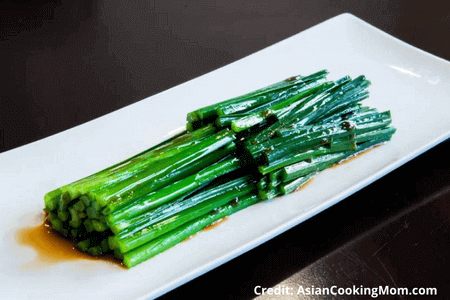
Sliced Pork & Chive Flower
Sandy’s Kitchen shows a vid for recipe for Sliced Pork & Chive Flower!
• 1.1lbs Chive Flower
• 0.5lbs Pork
• 1tsp Salt
• 0.5tsp Pepper
• 1tsp Corn Starch
• 1tsp Olive Oil
• 1tsp Soy Sauce
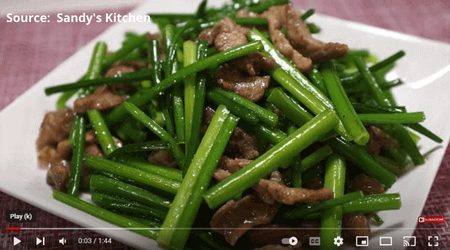
Garlic Chives and Chives Medicinal and Medical Benefits
1 HEPPY cannot take any responsibility for any adverse effects from the use of plants. Always seek advice from a professional before using a plant for food or medicinally. This information is intended for educational purposes only and should not be considered as a recommendation or an endorsement of any particular medical or health treatment.
Medicinal Benefits
Garlic Chives, Allium tuberosum
from Plants For A Future: The whole plant is antibacterial, cardiac, depurative, digestive, stimulant, stomachic and tonic[61, 174, 218]. It is an anti-emetic herb that improves kidney function[238]. It is used internally to treat urinary incontinence, kidney and bladder weaknesses etc[238]. The seed is carminative and stomachic[218]. They are used in India in the treatment of spermatorrhoea[240]. The leaves and the bulbs are applied to bites, cuts and wounds[218]. the reference page is here.
and NIH/PubMed study cites, “Allium tuberosum (AT) is traditionally used for treating nocturnal emissions, abdominal pain, diarrhea, sexual dysfunction and asthma.” however, they do not cite the source.
Chives, Allium schoenoprasum
from Plants For A Future: The whole plant has a beneficial effect on the digestive system and the blood circulation. It improves the appetite, is digestive, hypotensive and tonic[201]. It has similar properties to garlic (A. sativum), but in a much milder form, and it is rarely used medicinally[238]. the reference page is here.
Medical Benefits
Garlic Chives, Allium tuberosum
research from NIH/PubMed.
in general, Garlic Chives is awesome for experimental rats :/ Allium tuberosum alleviates pulmonary inflammation … in asthmatic mice and, Allium tuberosum Seeds have a role in promoting Testosterone Production of Rat Leydig Cells :/. i can have healthy rats….
at best, i found no negative information on Garlic Chives, Allium tuberosum. please place a set of eyes on these reports and let me know what you find. NIH/PubMed, search Allium tuberosum.
overall, Allium species are their benefits to human health:
- Allium species are investigated for “possible future” cancer treatment (NIH/PubMed, Allium vegetables for possible future of cancer treatment). that’s from a study with a wonderfully nebulous title :/.
- “The Allium species constituents have been shown to have antibacterial and antioxidant activities … These activities are related to their rich organosulfur compounds…organosulfur compounds are believed to prevent the development of cancer, cardiovascular, neurological, diabetes, liver diseases as well as allergy and arthritis.” (NIH/PubMed, Chemical constituents and medicinal properties of Allium species).
at worst, Garlic Chives appears to be a safe, healthy food. at best, it has biological properties that promotes a healthy lifespan.
Chives, Allium schoenoprasum
research from NIH/PubMed.
Chives, Allium schoenoprasum is studied for its antioxidants and anti-inflammatory activities.
- “extracts from all plant organs exhibited antioxidant activity. The highest antioxidant activity was observed in the leaves.” Allium schoenoprasum L., as a natural antioxidant.
- leaves have anti-inflammatory activities by “inhibiting phagocytosis through the reduction of nitro-oxidative stress.” (phagocytosis is at the cellular level). Pure extracts (100% concentration) had the best inhibitory activity on phagocytosis and oxidative stress. Anti-inflammatory effects of Allium schoenoprasum L. leaves.
- natural compounds in Chives (and two other herbs) inhibit cell proliferation (“potentially useful for the treatment and prevention of tumour diseases”). The three herbs studied were (A. schoenoprasum, T. pratensis and R. acetosa).
the study made an interesting conclusion: “The results suggest that antiproliferation activity does not depend exclusively on total phenolic compound content or composition, but it can be also influenced by other extracted active substances which were not detected.”
Phenolic Compounds from Allium schoenoprasum, Tragopogon pratensis and Rumex acetosa and Their Antiproliferative Effects.
Grow, Care and Propagate Garlic Chives
it grows as well as any weed IF weeds grew in only a few bunches. little water is needed, and she’s VERY easy to transplant and propagate.
General Care
Full sun and well-draining organic soil are optimal conditions. we do not fertilize Garlic Chives, Allium tuberosum.
she’s a perennial that will go dormant in colder zones. in zone 7, the green leaves die in January-February (Northern Hemisphere). by March, she faithfully begins growing. in August, flowers are in full bloom and seeds are mature by October.
recommended but not necessary:
1. Jan-Feb: prune-away dead growth.
2. September: deadhead.
Soil
Allium tuberosum grows best in well-draining soil. we grow it in very organic soil and the plant thrives in it. our soil is rich in woodchips — woodchips in varying stages of decomposition.
Sun
Allium tuberosum thrives in full sun. place it in a sunny location for the best growth — to produce the most healthy leaves and flowers. Allium tuberosum also grows in part shade. deadheading is important to prevent the plant from spreading.
Propagation
propagate by root division at virtually any time. divisions can be potted or planted straight out into their permanent positions. seeds germinate dependably in spring through summer.
Root Division
root division is the easiest method of propagation. Allium tuberosum is forgiving; the two bunches on the right were literally dug up by hand (soft soil ;), and are ready to be planted.
do water transplanted divisions. Allium tuberosum is drought tolerant once established but assure sufficient water after transplanting.
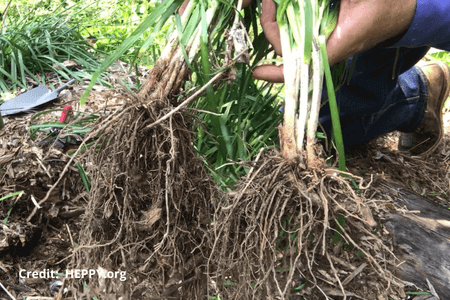
Seeds
flowers are in full bloom by end-of-August. blooms are spent by end-of-September and seeds quickly develop.
Allium tuberosum seeds have a HIGH germination rate. each flower head has ~40 seed pods, and there are 2-4 seeds in each pod! seed pods dry and crack open on their own. visible, hard dry black seeds can be easily harvested or, seeds can be allowed to fall on the ground to germinate the following spring.
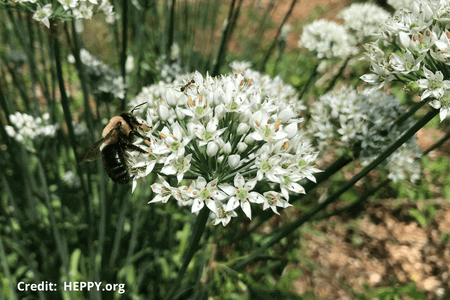


Garlic Chives growing in our Garden
it grows in our organically rich soil and we rarely — if ever — water them. we can eat the leaves, shoots & roots, flower stems and flowers. BUT i faithfully deadhead this girl. she self-seeds well!
TOO easy to Grow Organically
this vid and webpage shows just about EVERYTHING i learned about this lovely herb.
our Chives did not survive but the Garlic Chive is very dependable. we like dependable!
i saw no evidence of cultivars. this is the one plant. VERY popular in China, it’s an medicinal and culinary herb, and vegetable.
i’ll be redundant: is self-seeds well here at HEPPY™. so, harvest the blooming stalks as have Asian people for who knows how long. and enjoy!
References
Missouri Botanical Garden: Garlic Chives | Chives
Plants for a Future: Garlic Chives | Chives
Wikipedia: Garlic Chives | Chives
Insecticidal properties:
1. “crushed garlic chive leaves, garlic chive essential oil” repel the Asian Citrus Psyllid (Diaphorina citri Kuwayama or ACP), a vector of huanglongbing (one of the most destructive diseases of citrus worldwide).
2. Laboratory Evaluation of Acute Toxicity of the Essential Oil of Allium tuberosum Leaves and Its Selected Major Constituents Against Apolygus lucorum.
In China, Apolygus lucorum is a nuisance, aphid-like insect showing high population growth rate and strong spreading ability.
